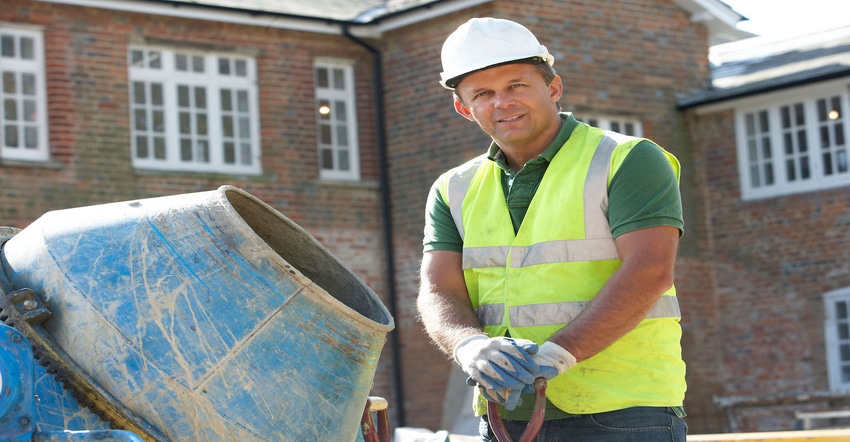9 Ways to Prevent Painful Cement Burns
It’s important to review the dangers and safety guidelines around this easily missed injury, which can have severe consequences if not handled properly.
May 11, 2023

In the midst of an ongoing and protracted labor shortage, it’s harder than ever for concrete contracting firms to find experienced workers. Many companies have been forced to bring on workers who have no experience in concrete work and are vulnerable to one of the scariest and most painful industry injuries—cement burns.
Cement burns result when skin comes into contact with wet cement. It contains calcium hydroxide and hexavalent chromium, which can cause chemical burns when exposed to unprotected skin. The longer the exposure, the more serious the burn, according to an American Society of Concrete Contractors Cement Burns Safety Bulletin. OSHA also offers guidelines on cement burn prevention along with related standards.
While the incidence of cement burns is low, according to the latest figures from the Bureau of Labor Statistics, new workers may not be fully aware of how dangerous cement exposure can be, or what to do about it if they are exposed, said Joe Whiteman, ASCC director of safety surfaces.
“You may just take it for granted that everyone knows what to do, but they don’t. It’s easy to surmise that we’re going to start seeing a rise in the types of injuries,” he said.
As cement workers become hot and sweaty, their pores open up, making burns even more severe when exposure happens. If not addressed, abrasives in concrete, combined with the chemical burning, can eat away skin over the course of a workday to the point where infection happens and skin grafts are required, warned Dan Boyd, safety director for Vee-Jay Cement Contracting Co.
“Cement burns are real, and we take it very seriously, because we know what it can mean,” Boyd said, adding that he’s experienced them himself. “People downplay the extent of the injury and don’t think it’s a big deal, especially the newbies.”
Forearms, hands, wrists, knees, lower legs and feet are most vulnerable to cement burns. When caught early, exposure to wet cement can cause redness and swelling similar to a sunburn. But too often, workers don’t know they’ve been exposed until the end of the day when the abrasive cement, combined with the heat of work, has done extensive damage.
Or they don’t do a good enough job washing off cement and fully neutralizing it, when it gets on them, Whiteman said.
“It can turn into an open wound, and it can be a severe second-degree burn if it’s not tended to properly,” he said. “There have been instances of where amputation was necessary because they let it go too far.”
On the heels of Construction Safety Week, here’s a look at nine ways to guard against cement burns from the ASCC Cement Burn Safety Bulletin, along with some extra guidance from Boyd:
1. Wear appropriate protective clothing and equipment. long sleeves, long pants, nonpermeable gloves and rubber boots made from butyl or nitrite material, safety glasses, and, if needed, a face shield. If you find plastic face shields are easily scratched or reduce visibility, try using mesh face shields as they are easily cleaned with water and last longer.
“Safety glasses cannot be overemphasized,” Boyd said. He added that he requires workers on vibrators and the hoses to wear face shields.
He also eschews rubber boots because of their tendency to get punctured in the course of working.
2. Utilize coveralls made from thin Tyvek. These provide a better layer of protection, while still allowing the worker not to overheat while handling hoses.
Boyd said the only workers he requires to wear coveralls are those who run the hoses and vibrators. “In the summer, it’s wicked hot,” he said. “And wearing those things is like being in a Ziploc bag.”
3. Use duct tape to wrap where the top of rubber boots and pants meet, and where gloves and long sleeves meet. Barrier creams serve as a good source of protection for commonly exposed areas.
Boyd said pant legs are the most important area to focus, and he asks workers to tape almost to the knee. “It keeps that area from getting saturated with concrete,” he said.
4. Immediately remove clothing splashed by wet concrete. Clean and wash exposed skin and monitor the area for irritation.
“Otherwise, that burning process will just continue to burn and burn until you have an infection,” Boyd said.
5. Remove jewelry, bracelets and watches as they increase opportunities for abrasion and areas for wet concrete to accumulate.
6. Ensure clean, potable water is available to wash exposed skin. “Don’t use the water in the concrete truck, because you don’t know what’s in that tank,” Boyd said. “Be sure you use bottled water or somewhere on the jobsite where you know the water is clean.”
7. Train workers on the hazards related to wet concrete, concrete burn prevention, and first aid. Boyd said it’s important to go back to new workers several weeks after their initial training to review safety guidelines.
“Even if you’ve explained it once, they haven’t really wrapped their minds around it, so you need to emphasize again how it important it is,” he said.
8. Wash work clothes contaminated with wet concrete separately from street clothes. Boyd recommends letting clothes completely dry out overnight and then shake them out to remove larger bits of concrete “so you don’t put it in your washer and destroy it, which I’ve done.”
9. Be proactive on the jobsite. Set up concrete burn prevention kits and have them readily available. Kits should include clean, absorbent towels, spare nitrile gloves, clean socks, eyewash solution and white vinegar.
White vinegar neutralizes cement’s chemical reaction with the skin, but it’s “like pouring fire on your soul,” Boyd warned. “When someone needs white vinegar, I always have them do it, because I don’t want to be punched in the face,” he said.
If exposure occurs and a concrete burn is sustained, the ASCC Cement Burn Safety Bulletin recommends the following:
Report exposures immediately.
Remove contaminated clothing.
If the concrete has dried, brush it off with a clean towel; adding water to dried concrete will only make matters worse.
Clean exposed skin thoroughly with a pH neutral soap without scent or alcohols. Do not use hand sanitizers. Vinegar can help neutralize the alkalinity of the burn.
If the eyes are exposed, flush with clean potable water for at least 20 minutes.
Monitor the area for signs of worsening.
Do not use creams or lotions containing lanolin or petroleum to treat the affected area.
If a doctor visit is required have the Safety Data Sheet available for the physician. Serious conditions may require antibiotics or more invasive treatments. Maintain communication with the physician to ensure all treatments and rehabilitation requirements are met.
About the Author(s)
You May Also Like




